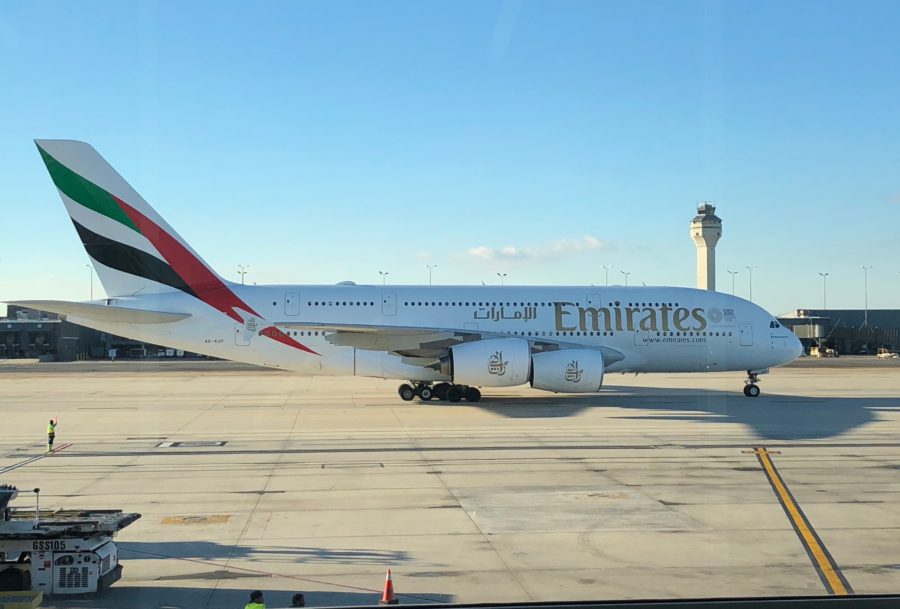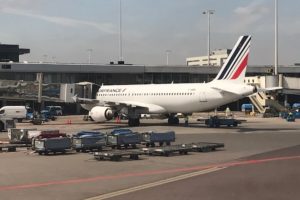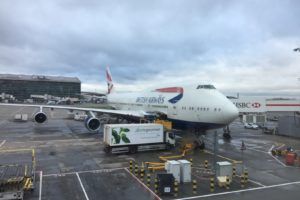A Guide To Flying The Airbus A380
The Airbus A380 is the largest commercial aircraft ever built as well as one of the most iconic aircraft ever built, possibly only after the 747. Unfortunately, a few days ago on February 14, Airbus announced that they would discontinue the A380 in the year 2021 with only 17 A380s on order, with three from ANA and 14 from Emirates. It was a sad day for aviation enthusiasts, although the announcement was much expected. The aircraft was unprofitable for most airlines and for Airbus as there really aren’t that many routes where that much capacity is feasible, especially as the plane has four expensive engines. Even on the routes that have high capacity, most airlines would just rather fly two A350s, 787s, or 777s at two times during the day (which makes the route more convenient for more people) instead of flying one A380 once.
That is, besides Emirates, who have saved the A380 on more than one occasion. They currently have about 109 of them in their fleet and will eventually have a total of 123 in their fleet once they are all delivered. They make up for almost half of the A380s ever produced and the A380 no doubt would have been canceled even earlier without the Emirates orders. With their business model of transporting as many passengers as they can through Dubai, connecting elsewhere in the world, and buying as few slots as possible, actually has worked for them. But one airline isn’t enough to save the plane, and the first A380s from Singapore Airlines actually have already gone to the boneyard. However, the A380 will still be in operation through the 2030s, so which airlines still fly it and to where?
Air France:

Air France has operated the Airbus A380 since 2009 and flies them from Paris to Shanghai, Abidjan (seasonal), Mexico City, Johannesburg, Los Angeles, Miami, New York, and Washington Dulles (seasonal). Air France has probably the worst premium cabins in business and first class. In business class, they have angle-flat seats in a 2-2-2 configuration and have lie flat but dated open suites in first class. Air France will retire 5 of their A380 within the next couple of years (as the aircraft are simply not profitable to them) but will refurbish the other 5 of them with their new cabin products to keep in their fleet for at least another few years after.
All Nippon Airways

ANA has a unique business model for their Airbus A380s. They originally only took an order for three of them (they took the orders over from Skymark Airlines) and plan to fly them all to Hawaii. ANA will all have different unique ocean-themed liveries and will only be flown from Tokyo (I think eventually both Narita and Haneda) to Honolulu (as of their current plans). They have cabin classes very similar to their 777s featuring first class, business class, premium economy, and economy class. They will commence service this summer starting with only 3x weekly service, then later they will receive daily, then 2x daily service. This is an interesting business model because a lot of Japanese like to visit Hawaii, so this is probably one of the routes where an A380 would make sense economically.
Asiana Airlines

Asiana Airlines have a small fleet of six Airbus A380s. They have mostly the same cabins as on their 777s or A350s with flat bed seats in a staggered 1-2-1 configuration in business class on the upper deck and closed suites in first class on the lower deck. They currently fly their Airbus A380s from Seoul to Sydney, Frankfurt, and Los Angeles (2x daily). Asiana currently doesn’t have any retirement plans for the aircraft and most likely won’t retire them any time soon as they took their first delivery of an Airbus A380 in 2014.
British Airways

British Airways has a total of 12 Airbus A380s in its fleet. There was
China Southern Airlines

China Southern only took delivery of five Airbus A380s starting in 2011. They are surprisingly the only airline from China to ever take delivery of the Airbus A380. They currently fly their A380s from Guangzhou to Beijing, Sydney, and Los Angeles. The aircraft also
Emirates

When you think of an A380, you probably think of Emirates. They took delivery of 109 of them and will bring that number up to 123 within the next two years. Emirates fly them to too many destinations to count as they have so many of them, so I won’t include them all; they do fly them to Los Angeles, San Francisco, Houston, New York (3x daily), Toronto, and Washington Dulles in North America. First class has closed suites in a 1-2-1 configuration and business class has staggered seats also in a 1-2-1 configuration.
Emirates’ A380s are pretty special because they have two things that many other airlines don’t have. First, they have shower suites available for
Etihad Airways

Etihad has a total of 10 Airbus A380s. They fly them to Sydney, Paris (2x daily), London (3x daily), New York, and will fly them to Seoul later this year. They took delivery of their first A380 in 2014 and probably won’t retire them that soon.
What makes Etihad’s A380s special are the premium cabins. First, it has a lounge area on its A380s which it calls “The Lobby” and is accessible for all first and business class passengers. Second, its first class “Apartments” feature both a chair and a bed, are in a 1-1 configuration, and can merge to form the upper half of a double bed with the neighboring suite. Finally, their A380s also contain the Residence. It is without a doubt the most exclusive cabin product of any airline and features a personal butler, a living room, personal shower suite, bedroom, a private lounge at the airport, and personalized everything.
Hi Fly

Hi Fly is the airline on this list that you have probably never heard of. That is because they are a short term leasing company that leases out aircraft to airlines when they are in need of extra aircraft. They recently acquired a used Airbus A380 (and don’t have plans to acquire any more) from Singapore Airlines which currently still features the same cabins that Singapore featured on their first Airbus A380s (closed suites in first, flat beds in business, etc).
Last summer and fall, they most notably leased the aircraft out to Norwegian on their New York to London route due to their engine problems and also leased it out to Air Austral until the plane was involved in a small jet bridge accident in Paris and was put out of service for a few months. The plane hasn’t been in scheduled service since due to the lack of demand for A380s, even on short term leases.
Korean Air

Korean Air has 10 Airbus A380s which fly from Seoul to Sydney, Paris, Taipei, Bangkok, Los Angeles (2x daily), and New York. They feature their old premium cabins layout which includes flat-bed seats in a 2-2-2 configuration (which aren’t very private and are slightly angled) and open suites in first class and doesn’t feature their new Apex Suites in business class. There were rumors that Korean Air would retire their first A380s in 2018, although those all turned out to be false, and I wouldn’t be surprised if they were to not retrofit the A380s and retire them sooner rather than later as they took delivery of their first ones in 2011.
Lufthansa

Lufthansa has 14 Airbus A380s which it started taking delivery of in 2010, making it the third largest operator of the aircraft. They fly the planes from Frankfurt to Delhi, Singapore, Bangkok, Houston, and Los Angeles, and from Munich to Hong Kong, Miami, and San Francisco. Lufthansa actually took delivery of their first A380s with angle-flat seats in business class, although they retrofitted them with their latest flatbed seats and premium economy in the mid-2010s. They also have a first class cabin with 8 open suites on their upper deck. Lufthansa hasn’t given the signal that it want to retire the A380 yet (and was even (falsely) rumored to be ordering more of them), and most likely will be flying for them for many more years.
Malaysia Airlines

Malaysia Airlines have six Airbus A380s which they took delivery of in 2012. Malaysia Airlines have been in a tricky situation since their disastrous 2014 (MH17 and MH370) which forced them to downsize drastically and retire their 777s. They then cut all of their Europe routes (besides the London route) and left their A380s only on their London route. Then they planned on selling their A380s to other airlines. And then they planned on using them only on Hajj flights to Saudi Arabia. Then, they planned on retiring them completely!
Fortunately, they now have kept them all in their fleet and fly them to Seoul, Tokyo, Sydney (seasonal), Melbourne (seasonal), and Jeddah (Hajj flights, 1x weekly). Your guess is as good as mine for how long they plan to keep their A380s in their fleet as they’ve changed their plans for them about a million times. They feature slightly angled seats in a 2-2-2 configuration in business class and eight open suites in first class.
Qantas

Qantas actually up until a few weeks ago had 8 more A380s on order. They had deferred them a few years ago but still technically had them on order until recently. They have a total of 12 of them in their fleet and fly them from Sydney to Hong Kong, Singapore (and then connecting on to London), Dallas, and Los Angeles and from Melbourne to Singapore and Los Angeles. Their A380s have a premium economy cabin, a business class cabin on the upper deck with flat-bed seats in a 2-2-2 configuration, and a first-class cabin consisting of open-suites in a 1-1-1 configuration.
Qantas plans to retrofit their entire A380 fleet with their new business class product (Thompson Vantage XL seats in a 1-2-1 configuration), their new premium economy seat, and with larger seating capacity. The first retrofitted aircraft should start flying this August. Qantas hasn’t given any indication of their A380 retirement plans, although you can bet on them keeping the aircraft for some time as they plan to retrofit them (which does cost money) with new cabins and haven’t given any indication to the contrary.
Qatar Airways

Qatar Airways has 10 Airbus A380s which they started taking delivery of in 2014. The airline flies the aircraft from Doha to Melbourne, Perth, Sydney, Guangzhou, Paris (2x daily), Bangkok, and London (2x daily). Qatar Airways does not have their fantastic QSuites in business class onboard their A380, although they do have standard reverse herringbone seats in business class. Their first class consists of 8 open suites, which is ironic, as their business class on some 777s or A350s (the Qsuite) has closable doors and double beds while their A380 first class has none of those things. Additionally, Qatar Airways has a bar/lounge on the upper deck similar to Emirates’ which first and business class passengers have access to.
Qatar Airways has signaled that they will start retiring their A380s in the year 2024 and will each individual plane after their 10-year leases are up (much like Singapore Airlines). They have said that their A380s would get a modified version of their QSuites, although that announcement came before they planned to retire them so I wouldn’t necessarily count on them retrofitting the aircraft.
Singapore Airlines

Singapore Airlines was the launch customer of the Airbus A380 and has a total of 19 of them in their fleet which means that they are the second largest A380 operator. They fly the plane from Singapore to Melbourne, Sydney (2x daily), Shanghai, Frankfurt (and onwards to New York JFK), Hong Kong, Delhi, Mumbai, Osaka, Auckland, Zurich, and London Heathrow (2x daily).
All of their A380s have a premium economy cabin which
They replaced the five that they got rid of with five more newer ones. Count on them keeping the rest of their A380s for as long as each individual one reaches its 10-year lease, which means that they probably will keep them at least into the late 2020s and possibly even into the 2030s.
Thai Airways

Thai Airways has only six Airbus A380s in its fleet which it flies from Bangkok to Paris Charles de Gaulle, Frankfurt, Tokyo Narita, and London Heathrow and started taking delivery of them in 2012. Their cabins consist of flat-bed staggered seats in a 1-2-1 configuration and a first class cabin with 12 open-suites. Thai Airways hasn’t given any indication regarding the timing of their A380 retirement so I would expect them to keep the aircraft in their fleet for a while longer.
Conclusion:
The Airbus A380 is a fantastic aircraft and is the largest commercial aircraft ever produced. Unfortunately, Airbus didn’t make a great economic decision by producing it and the aircraft isn’t very economically efficient for any airline, besides Emirates. It really is a shame that the A380 will go out of production by 2021 as the aircraft has only been in service a little over 10 years. While we all wish more airlines would order them as the plane is a customer favorite, I really can’t blame Airbus for canceling the plane given their substantial losses on it. Overall, the plane will still stay in service into the 2030s, although don’t expect it in service for much time after that as four-engined planes with too much capacity really aren’t as efficient as the modern two engined ones with reasonable capacity.
What do you think of the A380s end? Are you sad to see it go or do you think that it is in everyone’s best interest for it to be retired?




